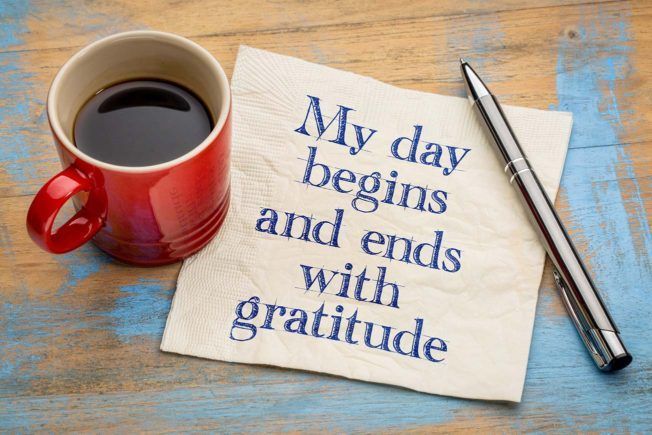Learn how to find your center. David Garcia shares five methods that will help you maintain a balanced and healthy life during challenging times.

5 Ways to Find Your Center
We all have moments when life’s demands leave us feeling stressed, scattered, exhausted, and more. Maybe you fell off your regular daily routine. It could also be a change in the weather, politics, increased stress at work or home, or anything else that threw a curveball in your mix. In these moments, it’s helpful to have simple coping methods to help you rebalance and find your center.
Here are five ways that have helped me recalibrate priorities and get back to being energetic and productive.
1. Meditation

Find your center through meditation. At the beginning of this year, I committed 10-15 minutes every morning to meditation. There’s a lot of research explaining the benefits of meditation. For me, meditation helped slow down the constant rush of thoughts that would continuously place me in the past (filling me up with regret) or the future (elevating my anxiety). By focusing on the breath and allowing my thoughts to “be,” I created a separation between the narrative in my head (which most of the time was negative), and my actual reality.
I meditated in the morning so that I could kick the day off with a fresher take. After a week, I noticed I had slightly less fog. I also felt less sluggish, which led to a more productive morning, better moods, and an overall better day. There were also unexpected bonuses through meditating. I was getting better sleep and understood how to let go of the tension that would build up throughout the day.
Whatever you focus on will expand. Whatever you give your attention, energy, and emotion too, will grow. Anahata
There are also useful apps that helped when I was in the mood for more specific guided meditations or topics related to mindfulness. A few of my go-to apps are 10% Happier, Calm, and the Waking Up App.
2. Journaling
Journaling is a practice that dates back millennia; some of the greatest philosophers and thinkers of our time were heavy journalers, including Marcus Aurelius and Seneca.
Journaling is easy to get started. There’s an entire economy dedicated to designing the coolest blank page journals. For instance, check out Icon Collective’s Art of Flow Journal or Moleskin. There are also guided journals that include daily tasks and goal setting, such as Best Self and Focus Journal.
You can start by journaling in the morning as “preparation for the day” or evenings as a “daily review.” For example, use journaling to outline the day ahead, set goals, or reflect on what you feel you did right/wrong and how you can improve. For instance, if I’m feeling stuck, I’ll start with questions as prompts such as:
- What made today meaningful?
- How do I feel about my choices today?
- What did I want to invest time in? But didn’t and why?
Another useful journaling technique is “stream of consciousness” writing. This approach involves writing continuously for three pages or 15 minutes. The trick is to keep writing no matter what, even if what you’re writing doesn’t make sense. This technique is also known as the “subconscious brain drain.” It will help you clear out the cobwebs that may clutter your focus and direction.
I lean on this practice during stressful times or when I have a lot of projects up in the air. Writing my thoughts down has a calming effect. It also allows me to contextualize the abstract and prioritize it. Once it’s on paper, the tasks seem less daunting, as well. It’s a fantastic way to re-align when things feel unmanageable.
3. Breathwork

Find your center through breathing techniques. The breathwork exercise I’ve explored is called “Pranayama” breathing. A few places in the LA area offer classes that teach this breathing technique. Check out breathwork classes from Rebecca Kordeki or Jon Paul Crimi.
During these 45-minute sessions, you lay flat on the floor, get comfy on a mat with a blanket, and practice various breathwork exercises. For example, you open your mouth, take in a deep breath to fill your belly, then take in a second big breath into your chest. Next, you gently release it all out of your mouth. You will also repeat this pattern while continuously keeping the breath circular and flowing, without stopping. Your body and limbs will start to feel tingly. You may even experience cramping and tightness in the hands or around the mouth. This experience is known as tetany and described by many as “ lobster claw ” hands.
I’ve done breathwork 6-7 times now. Even after the first session, I felt a profound transformation in my emotional response. The practice shook emotions loose, produced a change in my physiology, and got me out of my “thinking head.” I also encountered feelings of abundance, an immense sense of gratitude, and some release of deep-seated toxic emotions. I was so overwhelmed by the cathartic release near the end of the session; I cried for 10 minutes. The experience was truly magical.
4. Exercise or Movement

Inertia is the tendency of an object to remain at rest or in motion. Newton’s First Law of Motion states that an object will remain at rest or move at a constant speed in a straight line unless it’s acted on by an unbalanced force.
Exercise is particularly helpful if you’re in a funk, frustrated, or feeling sluggish. And the best way to change your state is to change your physiology with exercise and movement.
Start with 5-10 minutes of movement every day. Do something that makes you break a sweat, gets your heart rate up, and changes your state. You don’t need to get a gym membership, put on exercise gear, or drive five miles. Put on some running shoes, and go for a brisk 10-20 minute walk. If you can’t do that, try 10 burpees, 20 jumping jacks, or 20 squats.
If you’re up for a challenge, try something entirely out of your comfort zone. For example, indoor climbing, yoga, hiking, etc. For me, I joined a Spin class called Cycling Pigeon. This program will 100% push you to the limit. It’s also gratifying, and if you do it at 6 AM, you’ve set yourself up for a phenomenal day.
5. Gratitude

The Story of Two Wolves is a Cherokee Indian legend. It illustrates a battle between our good and bad thoughts. Here is how the story goes:
An old Cherokee is teaching his grandson about life. “A fight is going on inside me,” he said to the boy. “It is a terrible fight, and it is between two wolves. One is evil – he is anger, envy, sorrow, regret, greed, arrogance, self-pity, guilt, resentment, inferiority, lies, false pride, superiority, and ego.”
He continued, “The other is good – he is joy, peace, love, hope, serenity, humility, kindness, benevolence, empathy, generosity, truth, compassion, and faith. The same fight is going on inside you – and inside every other person, too.”
The grandson thought about it for a minute and then asked his grandfather, “Which wolf will win?” The old Cherokee simply replied, “The one you feed.”
First, sit back and objectively acknowledge whether you’re acting from a place of fear or a place of love and abundance. This process may not be clear right away. It could also take some time to understand. The point is, your thoughts create your reality. How you choose to be in life not only affects yourself but everyone and everything else. This knowledge is a powerful teaching that invites you to take responsibility for your choices. Even the tiniest ones have a ripple effect. For instance, how you speak, how you act, what you do, the energy you bring when you walk into a room — it all matters.
The most important question a human being can ask is, “Is the universe friendly? Albert Einstein
If you perceive the universe as friendly, then a positive outlook will enhance your cognitive function. However, when you lead with fear, anxiety, or scarcity, you narrow the focus to eliminate the threat. You also get stuck in a pattern of being reactive, and your choices become limited. As a result, stress levels rise.
Gratitude plays a critical role in human happiness. Research in Robert Emmons’ book “Thanks” explains that at the end of a 10-week experiment, participants who kept a gratitude journal felt better about their lives. They were also more optimistic about the future. When practicing gratitude writing, the key is to be specific. Here are examples of gratitude-inducing experiences:
- Waking up this morning
- Sitting and eating with my family
- Having hot water to shower with
The most significant benefit I discovered was it immediately put me in the now. however, gratitude also appreciates what you already have. By cultivating an attitude of gratitude, you think and feel certain things better. As a result, you will see a broader spectrum of possibilities.
Doing these exercises every day will help you with the process of re-writing malicious code. It will also help you determine the nature of the experience of your life.
Conclusion
I’ve worked with these modalities at different stages of my life; no magic button gets it all done. Experiment with different ones on different days to find what method resonates more. It takes practice and discipline to break any habit (good or bad). The trick is to find your rhythm and flow and stick to it. Over time, you will be able to find your center.

Turn your passion for music into a Profession: Learn more about our Music School Programs!
MORE ARTICLES FROM THE ICON BLOG

FIND YOUR SOUND, HONE YOUR CRAFT:
Are you ready to turn music into a career? ICON prepares students to become music producers, composers, performers, recording artists, professional DJs, and entrepreneurs in the entertainment industry. Click below to get information about our award-winning programs:

